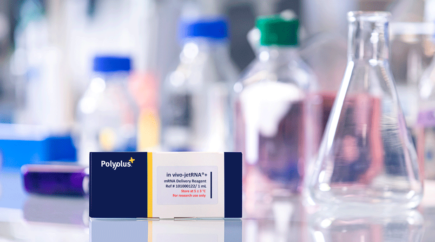in vivo-jetRNA®+ is a ready-to-use transfection reagent composed of lipid-based nanoparticles specifically developed for in vivo mRNA delivery.

RNA/DNA Therapeutics
Gold standard for in vivo delivery of DNA, siRNA, shRNA and miRNA
Versatile
Any nucleic acid to any organ/tissue through any common route of administration
Time-saving
Ready-to-use reagent requiring no equipment or formulation expertise
GMP grade availability
Manufactured according to both US and EU Guidelines
Successful
Excipient for in vivo delivery widely used from fundamental research to Human clinical trials
Proven
Well-documented in vivo transfection technology with over 600 peer-reviewed publications
| Type | Ready-to-use cationic polymer |
|---|---|
| Molecules delivered | DNA, siRNA, miRNA, shRNA, mRNA, saRNA or other oligonucleotides |
| Biodistribution and Injection routes | Universal biodistribution: Any organ or tissue (depending on the injection route) |
| Number of injections | 100 µl of in vivo-jetPEI® is sufficient to perform 15 to 25 intravenous injections in mice |
| Storage | Store in vivo-jetPEI® at -20 ± 5°C. |
| Product documentation | Protocol |
| Regulatory documentation | With GMP grade only: |
in vivo-jetPEI® is a ready-to-use cationic polymer reagent used for in vivo transfection of nucleic acids (DNA, siRNA, miRNA, shRNA and other oligonucleotides) in any animal model.
With more than 600 peer-reviewed publications, in vivo-jetPEI® is established in the field of in vivo delivery, whether for functional studies, oncology research as well as vaccination purposes. Additionally, in vivo-jetPEI® has the advantage of being available in 2 different quality grades (Research and GMP grades) to support our customers at each step of their development process.

These FAQs are organized by application to guide you to find the best answer possible.

You have access to all the documents related to the transfection reagent.

Search for publications in our Transfection Database with Polyplus transfection reagents

This lexicon will help you to understand the different terms related to Polyplus-transfection®.